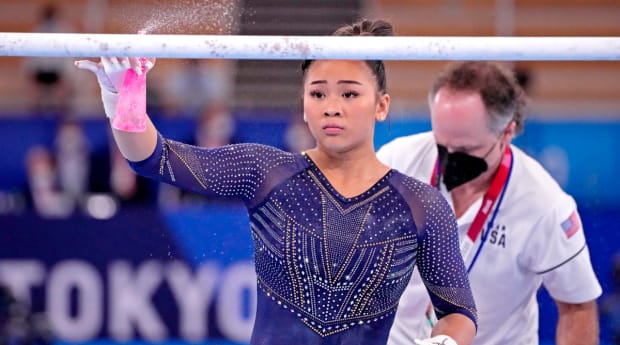On Sunday, the competitors in Tokyo, including the medalists on the vault, spoke out against the rule, citing the injury risk it presents.
Sign up for our free daily Olympics newsletter: Very Olympic Today. You'll catch up on the top stories, smaller events, things you may have missed while you were sleeping and links to the best writing from SI’s reporters on the ground in Tokyo.
TOKYO — Simone Biles inspired a conversation about mental health at these Olympics. On Sunday night, the major topic among the gymnasts was physical health.
Gymnasts are not allowed to warm up on the equipment they will use during competition in event finals. (They are allowed to warm up during qualifying rounds, team finals and the individual all-around final.) They work out in the practice gym, then wait for some 30 minutes before taking the floor.
“I think that rule is so dumb,” said Suni Lee, who won gold in the all-around final, silver in the team final and, on Sunday, bronze in the uneven bar final. “It’s so dangerous.”
Her coach, Jess Graba, agreed. “You could really get hurt doing this,” he said. “The routines are too difficult. The skills are too high-level.” He added that he would have felt that way even if Lee had won gold. “Every one of those kids fought,” he said. “They only had one fall, but they all struggled. That wasn’t their normal routine.”

USA Gymnastics and the International Gymnastics Federation did not return requests for comment.
Each of the medalists on the vault said they would have preferred the 30-second practice time, also known as a one touch warm-up. “If we had a chance to warm up, I think I would have been less anxious and nervous,” bronze medalist Yeo Seo-jeong, of South Korea, said through an interpreter. “We only had one chance at this.”
Most other sports allow their players to practice using the equipment they will see in games. Quarterbacks, for example, throw passes on the sideline. Relief pitchers warm up on the bullpen mound, then trot in and throw eight more pitches from the game mound.
The issue is more serious in gymnastics because of the danger of the routines. A fractional mistake could end in paralysis. And the apparatuses really are different: In the back gym, it sits on the floor, whereas in competitions it sits on a podium, making everything bouncier.
Graba said it was his understanding that the rule stems from a desire to keep broadcasts moving quickly. (NBC did not return a request for comment.) He was unmoved by that argument. “I care about my kid,” he said. “I don’t care about their ratings. My kid needs to be safe.” He pointed out that the medal ceremonies for each event, held before the next one could begin, delayed the broadcast more than a warm-up would. He suggested that TV broadcasts just air the warm-ups. Besides, he added, “They definitely don’t want to see a kid get hurt.”
More Olympics Coverage: